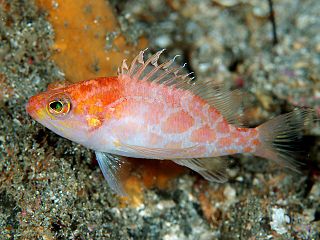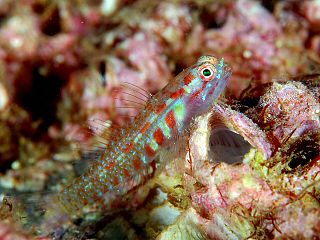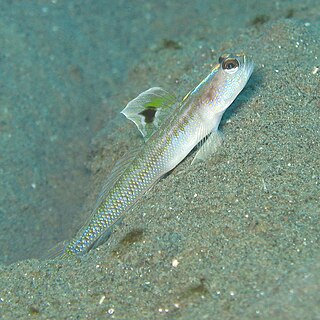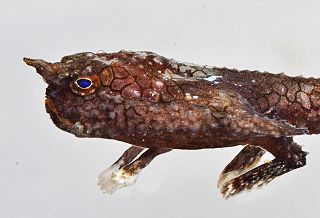
Gymnothorax is a genus of fish in the family Muraenidae found in Atlantic, Indian and Pacific Ocean. With more than 120 species, it the most speciose genus of moray eels.

Plectranthias is a genus of ray-finned fish in the subfamily Anthiinae, part of the family Serranidae, the groupers and sea basses. They are found in the Atlantic, Indian and Pacific Ocean.

Enneapterygius is a genus of fish in the family Tripterygiidae found in the Indian and Pacific Ocean.

Synodus is a genus of fish in the family Synodontidae found in Atlantic, Indian and Pacific Ocean.

Eviota is a genus of fish in the family Gobiidae, commonly as dwarfgobies found in the Indo-Pacific region, where it is distributed from Japan to Australia and from Africa to Pitcairn Island. Species are mainly associated with coral reefs. Many of these fish are short-lived, with life cycles as brief as 3.5 weeks in the tropics. Some species are hermaphrodites and some representatives live symbiotically among the tentacles of the mushroom coral.

Amblyeleotris is a genus of fish in the family Gobiidae found throughout the Indo-Pacific region. This is the largest genus of the shrimp gobies or prawn gobies, so-called because of their symbiotic relationship with certain alpheid shrimps. The shrimp excavates and maintains a burrow used by both animals while the goby, which has far superior eyesight, acts as a lookout for predators. The shrimp maintains almost constant contact with the fish with an antenna. These species vary considerably in size from less than 30 mm to almost 200 mm standard length.

Rhinogobius is a genus of primarily freshwater gobies native to tropical and temperate parts of eastern Asia. Most are small, streamlined in shape, and often sexually dimorphic. Few are of commercial importance, but R. duospilus is fairly widely traded as an aquarium fish.

Vanderhorstia is a genus of gobies native to the Indian and Pacific oceans. The name of this genus honours the Dutch biologist Cornelius van der Horst (1889-1951) of the University of The Witwatersrand, Johannesburg, who was well known for his interest in marine biology.

Tomiyamichthys is a genus of gobies found from the Red Sea through the Indian Ocean to the western Pacific Ocean. The name of this genus honours the Japanese ichthyologist Itiro Tomiyama of the Tokyo Imperial University, who described the type species, Tomiyamichthys oni, in 1936.

Malthopsis is a genus of batfishes with a wide distribution in the world's oceans. In 2021, five new species were described from Australia and M. provocator was resurrected from synonymy with M. lutea.
Metzia is a genus of cyprinid fish that is found in eastern Asia. The genus is named in honor of the American ichthyologist Charles William Metz of Stanford University.

Microphysogobio is a genus of freshwater fish in the family Cyprinidae native to East Asia.

Parapercis is a genus of sandperches belonging to the fish family Pinguipedidae.

Thysanophrys is a genus of flatheads native to the Indian Ocean and the western Pacific Ocean.
The black body moray is an eel in the family Muraenidae. It was described by Loh Kar-Hoe, Shao Kwang-Tsao, and Chen Hong-Ming in 2011. It is a tropical, marine eel which is known from southeastern Taiwan, in the Pacific Ocean. Males are known to reach a maximum total length of 49.6 cm, while females are known to reach a maximum of 50.4 cm.

Cabillus is a genus of gobies native to the Indian and Pacific oceans.
Discordipinna is a genus of gobies native to the Indian Ocean and the western Pacific Ocean.
Lotilia is a small genus of gobies native to the Indo-Pacific region. The members of this genus are commensal with shrimps of the genus Alpheus.

Pseudogobius is a genus of fish in the goby family, Gobiidae. It is widely distributed in tropical and temperate regions of the Indian and western Pacific Oceans. Species occur in freshwater and estuarine habitat types, such as mangroves and seagrass beds.

Nanhaipotamon is a genus of freshwater crabs, in the subfamily Potamiscinae, found in southern China and Taiwan. As of 2018, 18 species have been described. The genus is named after the South China Sea, for it occurs mostly in coastal areas.
















